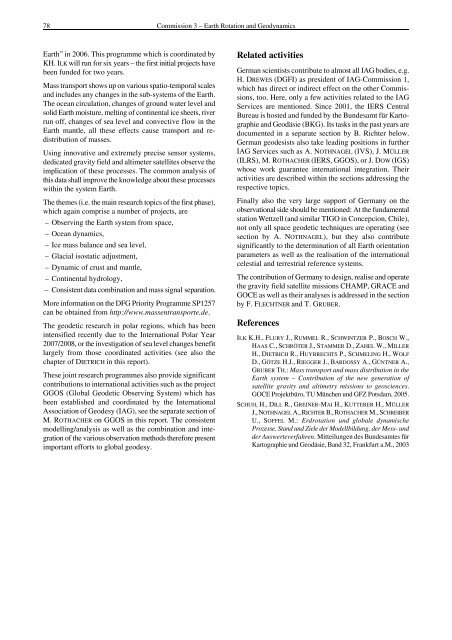NATIONAL REPORT OF THE FEDERAL REPUBLIC OF ... - IAG Office
NATIONAL REPORT OF THE FEDERAL REPUBLIC OF ... - IAG Office
NATIONAL REPORT OF THE FEDERAL REPUBLIC OF ... - IAG Office
You also want an ePaper? Increase the reach of your titles
YUMPU automatically turns print PDFs into web optimized ePapers that Google loves.
78 Commission 3 – Earth Rotation and Geodynamics<br />
Earth” in 2006. This programme which is coordinated by<br />
KH. ILK will run for six years – the first initial projects have<br />
been funded for two years.<br />
Mass transport shows up on various spatio-temporal scales<br />
and includes any changes in the sub-systems of the Earth.<br />
The ocean circulation, changes of ground water level and<br />
solid Earth moisture, melting of continental ice sheets, river<br />
run off, changes of sea level and convective flow in the<br />
Earth mantle, all these effects cause transport and redistribution<br />
of masses.<br />
Using innovative and extremely precise sensor systems,<br />
dedicated gravity field and altimeter satellites observe the<br />
implication of these processes. The common analysis of<br />
this data shall improve the knowledge about these processes<br />
within the system Earth.<br />
The themes (i.e. the main research topics of the first phase),<br />
which again comprise a number of projects, are<br />
– Observing the Earth system from space,<br />
– Ocean dynamics,<br />
– Ice mass balance and sea level,<br />
– Glacial isostatic adjustment,<br />
– Dynamic of crust and mantle,<br />
– Continental hydrology,<br />
– Consistent data combination and mass signal separation.<br />
More information on the DFG Priority Programme SP1257<br />
can be obtained from http://www.massentransporte.de.<br />
The geodetic research in polar regions, which has been<br />
intensified recently due to the International Polar Year<br />
2007/2008, or the investigation of sea level changes benefit<br />
largely from those coordinated activities (see also the<br />
chapter of DIETRICH in this report).<br />
These joint research programmes also provide significant<br />
contributions to international activities such as the project<br />
GGOS (Global Geodetic Observing System) which has<br />
been established and coordinated by the International<br />
Association of Geodesy (<strong>IAG</strong>), see the separate section of<br />
M. ROTHACHER on GGOS in this report. The consistent<br />
modelling/analysis as well as the combination and integration<br />
of the various observation methods therefore present<br />
important efforts to global geodesy.<br />
Related activities<br />
German scientists contribute to almost all <strong>IAG</strong> bodies, e.g.<br />
H. DREWES (DGFI) as president of <strong>IAG</strong>-Commission 1,<br />
which has direct or indirect effect on the other Commissions,<br />
too. Here, only a few activities related to the <strong>IAG</strong><br />
Services are mentioned. Since 2001, the IERS Central<br />
Bureau is hosted and funded by the Bundesamt für Kartographie<br />
and Geodäsie (BKG). Its tasks in the past years are<br />
documented in a separate section by B. Richter below.<br />
German geodesists also take leading positions in further<br />
<strong>IAG</strong> Services such as A. NOTHNAGEL (IVS), J. MÜLLER<br />
(ILRS), M. ROTHACHER (IERS, GGOS), or J. DOW (IGS)<br />
whose work guarantee international integration. Their<br />
activities are described within the sections addressing the<br />
respective topics.<br />
Finally also the very large support of Germany on the<br />
observational side should be mentioned: At the fundamental<br />
station Wettzell (and similar TIGO in Concepcion, Chile),<br />
not only all space geodetic techniques are operating (see<br />
section by A. NOTHNAGEL), but they also contribute<br />
significantly to the determination of all Earth orientation<br />
parameters as well as the realisation of the international<br />
celestial and terrestrial reference systems.<br />
The contribution of Germany to design, realise and operate<br />
the gravity field satellite missions CHAMP, GRACE and<br />
GOCE as well as their analyses is addressed in the section<br />
by F. FLECHTNER and T. GRUBER.<br />
References<br />
ILK K.H., FLURY J., RUMMEL R., SCHWINTZER P., BOSCH W.,<br />
HAAS C., SCHRÖTER J., STAMMER D., ZAHEL W., MILLER<br />
H., DIETRICH R., HUYBRECHTS P., SCHMELING H., WOLF<br />
D., GÖTZE H.J., RIEGGER J., BARDOSSY A., GÜNTNER A.,<br />
GRUBER TH.: Mass transport and mass distribution in the<br />
Earth system – Contribution of the new generation of<br />
satellite gravity and altimetry missions to geosciences.<br />
GOCE Projektbüro, TU München und GFZ Potsdam, 2005.<br />
SCHUH, H., DILL R., GREINER-MAI H., KUTTERER H., MÜLLER<br />
J., NOTHNAGEL A., RICHTER B., ROTHACHER M., SCHREIBER<br />
U., S<strong>OF</strong>FEL M.: Erdrotation und globale dynamische<br />
Prozesse. Stand und Ziele der Modellbildung, der Mess- und<br />
der Auswerteverfahren. Mitteilungen des Bundesamtes für<br />
Kartographie und Geodäsie, Band 32, Frankfurt a.M., 2003











